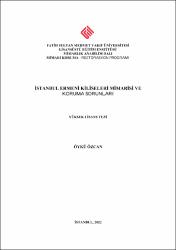| dc.contributor.advisor | Ertuğrul, Alidost | |
| dc.contributor.author | Özcan, Öykü | |
| dc.date.accessioned | 2023-04-03T08:08:06Z | |
| dc.date.available | 2023-04-03T08:08:06Z | |
| dc.date.issued | 2022 | en_US |
| dc.identifier.citation | ÖZCAN, Öykü, İstanbul Ermeni Kiliseleri Mimarisi ve Koruma Sorunları, Fatih Sultan Mehmet Vakıf Üniversitesi Lisansüstü Eğitim Enstitüsü Mimarlık Anabilim Dalı Mimari Koruma - Restorasyon Programı,Yayımlanmamış Yüksek Lisans Tezi, İstanbul 2022. | en_US |
| dc.identifier.uri | https://hdl.handle.net/11352/4460 | |
| dc.description.abstract | İstanbul Ermeni kiliselerini ve koruma sorunlarını konu alan bu çalışmada günümüze kadar varlığını sürdürmüş olan, Türkiye Ermenileri Patrikliği ve Türkiye Katolik Ermeni Patrikhanesinin izin verdiği on iki Gregoryen, üç Katolik ve iki Protestan kilisesi olmak üzere toplam on yedi adet Ermeni kilisesi ele alınmıştır. İstanbul‟da bulunan Ermeni kiliselerinin mimarisini ve koruma sorunlarını anlatan bu tez beş ana bölümden oluşmaktadır.
Birinci bölüm, MÖ 6. yy'da Ermenilerin ilk ortaya çıkışı ve Ermenilerin Hristiyanlık dininden önce çok tanrılı “ politeist” bir dine mensup olması hakkında bilgi verilmiştir. Bugünkü Ermeni Cemaatinin temelleri 19. yy‟da atılmış ve Ermeniler için bir Rönesans dönemi olmuştur. Ancak yeniliklerin yaşandığı bu dönem ayrılıklarda görülmüştür. Bunun sonucunda meydana gelen Katolik ve Protestan Ermeni Cemaati'nin oluşumu ve ayrılması hakkında bilgi verilmiştir.
İkinci bölüm, 19. yy‟da Osmanlı devletinde idari, ekonomik, sosyal ve kültürel alanda birçok değişim yaĢanmış ve bu değişim mimariyede etki etmiştir. Oluşan bu yeni mimari üsluba göre kiliselerin biçimlenmesi anlatılmış, Ermeni cemaatinin neden böyle bir yapıya ihtiyaç duyduğu ve zaman içerisinde kilise yapısının nasıl şekillendiği kullanım amaçlarına göre hangi bölümlere ayrıldığı konusu ele alınmıştır. Bu bağlamda narteks, naos, bema, apsis, vaftizhane, galeri ve çan kulesi incelenmiştir.
Üçüncü bölüm, İstanbul‟un bazı semtlerinde zaman içerisinde Ermeni nüfus‟u artış
gösterirken bazı semtlerinde azalma görülmüştür. Buna bağlı olarak zamanla yok olmuş ve günümüzde kadar varlığını sürdürmüş olan, Gregoryen Ermeni Kiliseleri, Katolik Ermeni kiliseleri ve Protestan Ermeni kiliseleri son inşa tarihlerine göre kronolojik olarak sıralanmış ve çizelge ile gösterilmiştir.
Dördüncü bölüm, Yapıların gördüğü zararlar boyutlarına göre patinalanma, bozulma ve hasar olmak üzere hafiften şiddetliye göre sıralanmış, yapılarda malzeme ve strüktürde bozulmaya neden olan iklimsel, biyolojik, doğal ve insanlardan kaynaklı etkenler anlatılmıştır.
Beşinci bölüm, Tez kapsamında bulunan on yedi kilisenin tarihi ve mimari özellikleri hakkında bilgi verilmiş, bu kiliselerin zaman içindeki işlevi ve değişimleri incelenmiştir. Yapıların mevcut durumu ve koruma sorunları ayrıntılı olarak fotoğraflarla belgelenmiş çeşitli yazılı ve sözlü kaynak araştırmaları yapılarak, yapının günümüz koşullarında korunarak varlığını sürdürebilmesi ve gelecek kuşaklara aktarılabilmesi için öneriler geliştirilmiştir. | en_US |
| dc.description.abstract | In this study, a total of seventeen Armenian churches including twelve Gregorian, three Catholic and two Protestant churches, which were allowed by the Turkish Armenian Patriarchate and the Turkish Catholic Armenian Patriarchate, that have survived to the present day, which are about the Armenian churches of Istanbul and their protection problems, are handled. This thesis, which describes the architecture and conservation problems of the Armenian churches in Istanbul, consists of five main parts.
In the first chapter; After mentioning the first appearance of Armenians in the 6th century BC; Information is given about his belonging to a polytheistic "polytheistic" religion before Christianity. The foundations of today's Armenian community were laid in the 19th century and it was a Renaissance period for Armenians. However, in this period when innovations were experienced, it was seen in the separations. As a result of this, information was given about the formation and separation of the Catholic and Protestant Armenian Community.
In the second chapter; In the 19th century, many changes were experienced in the Ottoman state in such administrative, economic, social, and cultural fields and these changes had an impact on architecture. This new architectural style discussed how the church structure was shaped over time and which parts were divided according to its usage purposes. In addition, the formation of the churches has been explained as to why the Armenian community needs such a structure; the narthex, naos, bema, apse, baptistery, gallery, and bell tower were examined in this context.
In the third chapter; Over time, while the Armenian population increased in some districts of Istanbul, it decreased in some districts. Accordingly, the Gregorian Armenian, Catholic Armenian and Protestant Armenian churches, which disappeared over time and are open to worship today, are shown in a chronological chart according to their last construction dates.
In the fouth chapter; The damages to the construction are listed from mild to severe as patina, deterioration and harm; climatic, biological, natural and human-induced factors that cause deterioration in materials and structure in constructions are explained
In the fifth chapter; Information about the general history and architectural characteristics of the selected 17 churches was given within the scope of the thesis, and the functions of these churches and their changes over time were examined. The current situation and conservation problems of the buildings have been documented in detail with photographs, various written and oral sources have been researched, and suggestions have been developed so that the structure can be preserved in today's conditions and transferred to future generations. | en_US |
| dc.language.iso | tur | en_US |
| dc.publisher | Fatih Sultan Mehmet Vakıf Üniversitesi, Lisansüstü Eğitim Enstitüsü | en_US |
| dc.rights | info:eu-repo/semantics/openAccess | en_US |
| dc.subject | Ermeni Kilisesi | en_US |
| dc.subject | Kilise Mimarisi | en_US |
| dc.subject | Kiliseler | en_US |
| dc.subject | Bazilika | en_US |
| dc.subject | Koruma Sorunu | en_US |
| dc.subject | Armenian Church | en_US |
| dc.subject | Church Architecture | en_US |
| dc.subject | Churches | en_US |
| dc.subject | Basilica | en_US |
| dc.subject | Conservation Issue | en_US |
| dc.title | İstanbul Ermeni Kiliseleri Mimarisi ve Koruma Sorunları | en_US |
| dc.title.alternative | Architecture and Preservation Problems of Armenian Churches | en_US |
| dc.type | masterThesis | en_US |
| dc.contributor.department | FSM Vakıf Üniversitesi, Lisansüstü Eğitim Enstitüsü, Mimarlık Ana Bilim Dalı Ana Bilim Dalı | en_US |
| dc.relation.publicationcategory | Tez | en_US |
| dc.contributor.institutionauthor | Özcan, Öykü | |



















